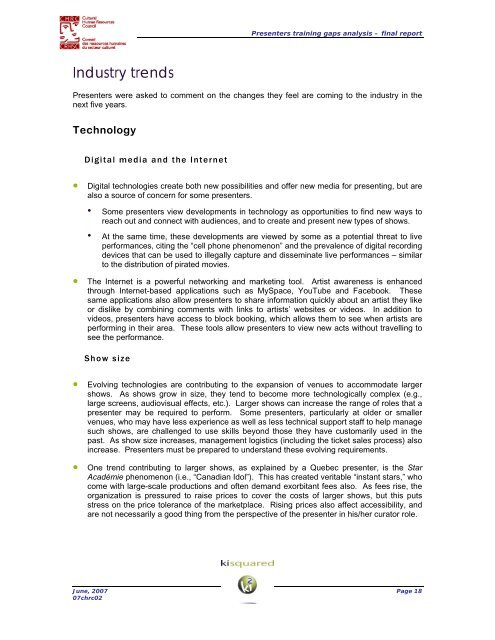Presenters Training Gaps Analysis - Conseil des ressources ...
Presenters Training Gaps Analysis - Conseil des ressources ...
Presenters Training Gaps Analysis - Conseil des ressources ...
Create successful ePaper yourself
Turn your PDF publications into a flip-book with our unique Google optimized e-Paper software.
<strong>Presenters</strong> training gaps analysis – final report<br />
Industry trends<br />
<strong>Presenters</strong> were asked to comment on the changes they feel are coming to the industry in the<br />
next five years.<br />
Technology<br />
Digital media and the Internet<br />
• Digital technologies create both new possibilities and offer new media for presenting, but are<br />
also a source of concern for some presenters.<br />
• Some presenters view developments in technology as opportunities to find new ways to<br />
reach out and connect with audiences, and to create and present new types of shows.<br />
• At the same time, these developments are viewed by some as a potential threat to live<br />
performances, citing the “cell phone phenomenon” and the prevalence of digital recording<br />
devices that can be used to illegally capture and disseminate live performances – similar<br />
to the distribution of pirated movies.<br />
• The Internet is a powerful networking and marketing tool. Artist awareness is enhanced<br />
through Internet-based applications such as MySpace, YouTube and Facebook. These<br />
same applications also allow presenters to share information quickly about an artist they like<br />
or dislike by combining comments with links to artists’ websites or videos. In addition to<br />
videos, presenters have access to block booking, which allows them to see when artists are<br />
performing in their area. These tools allow presenters to view new acts without travelling to<br />
see the performance.<br />
Show size<br />
• Evolving technologies are contributing to the expansion of venues to accommodate larger<br />
shows. As shows grow in size, they tend to become more technologically complex (e.g.,<br />
large screens, audiovisual effects, etc.). Larger shows can increase the range of roles that a<br />
presenter may be required to perform. Some presenters, particularly at older or smaller<br />
venues, who may have less experience as well as less technical support staff to help manage<br />
such shows, are challenged to use skills beyond those they have customarily used in the<br />
past. As show size increases, management logistics (including the ticket sales process) also<br />
increase. <strong>Presenters</strong> must be prepared to understand these evolving requirements.<br />
• One trend contributing to larger shows, as explained by a Quebec presenter, is the Star<br />
Académie phenomenon (i.e., “Canadian Idol”). This has created veritable “instant stars,” who<br />
come with large-scale productions and often demand exorbitant fees also. As fees rise, the<br />
organization is pressured to raise prices to cover the costs of larger shows, but this puts<br />
stress on the price tolerance of the marketplace. Rising prices also affect accessibility, and<br />
are not necessarily a good thing from the perspective of the presenter in his/her curator role.<br />
June, 2007<br />
07chrc02<br />
Page 18










